List of cnidarians of Ireland
There are 302 species of cnidarians (phylum Cnidaria) recorded in Ireland.[1]
The cnidarians' distinguishing feature is cnidocytes, specialized cells that they use mainly for capturing prey. Their bodies consist of mesoglea, a non-living jelly-like substance, sandwiched between two layers of epithelium that are mostly one cell thick. They have two basic body forms: swimming medusae and sessile polyps, both of which are radially symmetrical with mouths surrounded by tentacles that bear cnidocytes. Both forms have a single orifice and body cavity that are used for digestion and respiration. Many cnidarian species produce colonies that are single organisms composed of medusa-like or polyp-like zooids, or both (hence they are trimorphic).[2][3][4]
Cnidarians found in Ireland and Irish waters include sea pens, sea anemones, hydroids, sea jellies ("jellyfish") and corals.
Class Anthozoa
Order Actiniaria (sea anemones)
Family Actiniidae
- Actinia equina (beadlet anemone)
- Actinia fragacea (strawberry anemone)
- Anemonia viridis (snakelocks anemone)
- Anthopleura ballii (red speckled anemone)
- Aulactinia verrucosa (gem anemone)
- Urticina eques
- Urticina felina (northern red anemones, dahlia anemone)
Family Actinostolidae
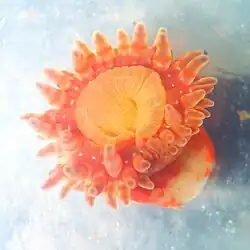
Family Aiptasiidae
Family Capneidae
- Capnea sanguinea
Family Edwardsiidae
- Edwardsia claparedii
- Edwardsia delapiae
- Edwardsia timida (timid burrowing anemone)
- Edwardsiella carnea
- Scolanthus callimorphus
Family Gonactiniidae
Family Halcampidae
- Halcampa chrysanthellum
Family Halcampoididae
- Halcampoides elongatus
Family Haloclavidae
Family Hormathiidae
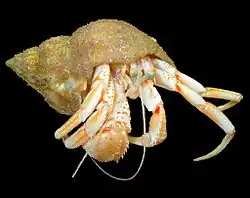
- Adamsia carciniopados
- Adamsia palliata (cloak anemone)
- Calliactis parasitica
- Cataphellia brodricii
- Hormathia coronata
Family Metridiidae
- Metridium senile (plumose anemone, frilled anemone)
Family Sagartiidae
- Actinothoe sphyrodeta
- Cereus pedunculatus (daisy anemone)
- Phellia gausapata
- Sagartia elegans
- Sagartia ornata
- Sagartia troglodytes (mud sagartia, cave-dwelling anemone)
- Sagartiogeton laceratus
- Sagartiogeton undatus
Order Alcyonacea (soft corals)
Family Alcyoniidae
_2.jpg)
- Alcyonium digitatum (dead man's fingers)
- Alcyonium glomeratum (red sea fingers)
- Alcyonium hibernicum (pink sea fingers)
- Parerythropodium coralloides
Family Gorgoniidae
- Eunicella verrucosa (broad sea fan, pink sea fan, warty gorgonian)
Family Plexauridae
- Swiftia pallida (northern sea fan)
Order Ceriantharia (tube-dwelling anemone)
Family Arachnactidae
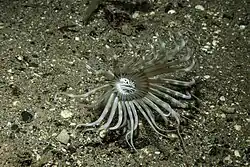
Family Cerianthidae
- Cerianthus lloydii (lesser cylinder anemone)
- Pachycerianthus multiplicatus (firework anemone)
Order Corallimorpharia
Family Corallimorphidae
Order Pennatulacea (sea pens)
Family Virgulariidae
Order Zoantharia
Family Epizoanthidae
- Epizoanthus couchii
Family Parazoanthidae
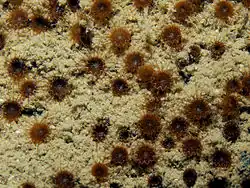
- Isozoanthus sulcatus
- Parazoanthus anguicomus
- Parazoanthus axinellae (yellow cluster anemone)
Class Hydrozoa
Order Anthoathecata (athecate hydroids)
Family Bougainvilliidae
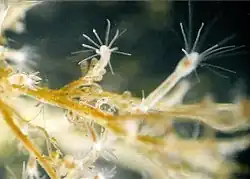
- Bougainvillia muscus
- Garveia nutans
Family Candelabridae
- Candelabrum phrygium
Family Corymorphidae
Family Corynidae
- Coryne eximia
- Coryne muscoides
- Sarsia densa
Family Eudendriidae
.jpg)
Family Hydractiniidae
.png)
- Clava multicornis
- Hydractinia echinata (snail fur)
Family Hydridae (hydras)
- Hydra viridissima (green hydra)[5]
- Hydra vulgaris (common hydra)[5]
Family Pandeiidae
- Leuckartiara octona
- Neoturris pileata
Family Porpitidae (chondrophores)
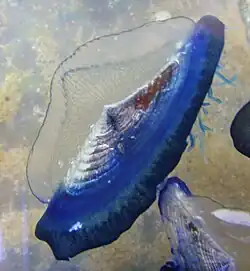
- Velella velella (sea raft, by-the-wind sailor, purple sail, little sail)
Family Tubulariidae
.png)
- Ectopleura larynx
- Tubularia indivisa (oaten pipes hydroid)
Order Leptomedusae (thecate hydroids)
Family Aequoreidae
Family Aglaopheniidae
- Aglaophenia acacia
- Aglaophenia kirchenpaueri
- Aglaophenia pluma (toothed feather hydroid, podded hydroid)
- Aglaophenia tubiformis
- Aglaophenia tubulifera
- Gymnangium montagui
- Lytocarpia myriophyllum
Family Campanulariidae
- Campanularia hincksii
- Clytia hemisphaerica
- Laomedea angulata
- Laomedea flexuosa
- Obelia dichotoma
- Obelia geniculata
- Obelia longissima
- Obelia plicata
- Rhizocaulus verticillatus
Family Haleciidae
- Halecium beanii
- Halecium halecinum
- Halecium muricatum
- Halecium plumosum
Family Halopterididae
- Antennella secundaria
- Halopteris catharina
- Schizotricha frutescens
Family Kirchenpaueriidae
Family Lafoeidae
- Lafoea dumosa
Family Plumulariidae
- Nemertesia antennina
- Nemertesia ramosa
- Plumularia argentea
- Plumularia cupressina
- Plumularia distans
- Plumularia setacea (plumed hydroid, little sea bristle)
- Polyplumaria flabellata
Family Sertulariidae
- Abietinaria abietina
- Abietinaria filicula
- Amphisbetia operculata
- Diphasia alata
- Diphasia attenuata
- Diphasia fallax
- Diphasia nigra
- Diphasia pinaster
- Diphasia rosacea
- Dynamena pumila
- Hydrallmania falcata
- Sertularella fusiformis
- Sertularella gayi
- Sertularella mediterranea
- Sertularella polyzonias
- Sertularella rugosa
- Tamarisca tamarisca
- Thuiaria articulata (jointed hydroid)
- Thuiaria thuja
Order Limnomedusae
Family Olindiidae
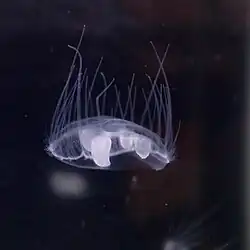
Order Siphonophorae (siphonophores)
Family Apolemiidae
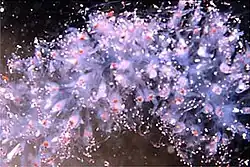
- Apolemia uvaria (string jellyfish, barbed wire jellyfish, long stringy stingy thingy)
Family Physaliidae
.jpg)
- Physalia physalis (Portuguese man-o'-war, blue bottle, floating terror)
Class Scyphozoa (true sea jellies)
Order Rhizostomeae
Family Rhizostomatidae
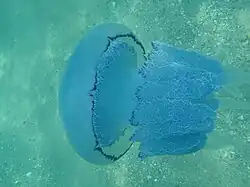
- Rhizostoma pulmo (barrel jelly, dustbin-lid jelly, frilly-mouthed jelly)
Order Semaeostomeae (flag-mouth sea jellies)
Family Cyaneidae
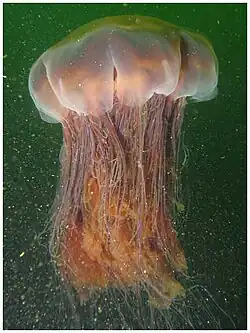
- Cyanea capillata (lion's mane jelly)
- Cyanea lamarckii (blue jelly, bluefire)
Family Pelagiidae
- Chrysaora hysoscella (compass jelly)
- Pelagia noctiluca (mauve stinger)
Family Ulmaridae
- Aurelia aurita (moon jelly, common jelly, saucer jelly)
Order Scleractinia (stony corals, hard corals)
Family Caryophylliidae

- Caryophyllia inornata
- Caryophyllia smithii (Devonshire cup coral)
- Lophelia pertusa[7]
Family Oculinidae
.jpg)
- Madrepora oculata (zigzag coral)[7]
Class Staurozoa
Order Stauromedusae (stalked jellies)
Family Craterolophidae
- Craterolophus convolvulus
Family Kishinouyeidae
- Lucernariopsis campanulata
Family Lucernariidae
- Haliclystus auricula (kaleidoscope jelly)
References
- ^ "Irish Biodiversity: a taxonomic inventory of fauna" (PDF). Retrieved 2023-08-21.
- ^ "Species Browser".
- ^ "Home" (PDF).
- ^ "Sea Anemones and Corals - OceanAddicts".
- ^ a b "Common Hydra (Hydra vulgaris) - Detail - Biodiversity Maps".
- ^ "Craspedacusta sowerbyi - Detail - Biodiversity Maps".
- ^ a b "Coral reefs in Irish Waters".